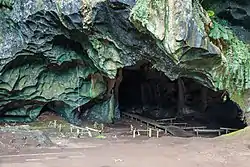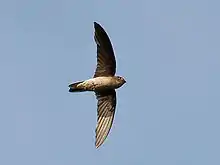| Madai Cave | |
|---|---|
 Entrance to the cave. | |
| Entrances | 1 |
Madai Cave is a cave located in Kunak, Sabah, Malaysia. It is an integral part of the limestone hills range located within the Baturong Madai Forest Reserve.[1]
Earliest human habitation
The earliest known human settlement in northern Borneo existed 20,000–30,000 years ago, as evidenced by stone tools and food remains found by excavations along the Darvel Bay area at Madai-Baturong caves near the Tingkayu River.[2] There were also old burial sites in the cave although the identity of those buried there remain unknown to most villagers living near the cave.[3]
Bird nest harvesting
The cave is famed as a source for swiftlet's nests used in bird's nest soup,[4] with demands largely come from the Chinese community especially during Chinese New Year.[5] Twice a year (between February and April, and between July and September), licensed collectors risk their lives climbing to the roof of these caves using only rattan ladders, ropes, and bamboo poles precariously attached together.[5] It is a special festival event for the local Ida'an villagers,[6][7] who have held the rights to Madai Caves for over 20 generations.[8] Although the Ida'an are the major producer, the community are not a consumer with the bird nest will be sold to a middlemen who in turn supply to consumers in Hong Kong and Singapore.[9]
 A swiftlet's nest from the cave.
A swiftlet's nest from the cave. A black-nest swiftlet.
A black-nest swiftlet.
Beside the bird nest harvesting, phosphate deposits from the swiftlet and bat were also collected for use as fertiliser.[3]
In popular culture
The cave was featured during the American adventure race programme of Eco-Challenge in the 2000 edition, where participants had to climb rattan ladders.[3]
References
- ↑ "Madai Cave". Sabah Wildlife Department. Archived from the original on 22 October 2017. Retrieved 22 October 2017.
- ↑ Kathy MacKinnon (1996). The Ecology of Kalimantan. Periplus Editions. pp. 55–57. ISBN 978-0-945971-73-3.
Since 1980, the Sabah Museum staff have carried out excavations in the Madai and Baturong limestone massifs, at caves and open sites dated back 30,000 years. Baturong is surrounded by large area of alluvial deposits, formed by the damming of the Tingkayu River by a lava flow. The Tingkayu stone industry shows a unique level of skills for its period. The remains of many mammals, snakes, and tortoises were found, all food items collected by early occupants of the rock shelters.
- 1 2 3 Liz Price (3 July 2010). "Exploring the hidden depths". The Star. Archived from the original on 22 October 2017. Retrieved 22 October 2017.
- ↑ Talia Avakian (24 June 2016). "Inside the dangerous process that goes into collecting one of the most expensive food products in the world". Business Insider. Archived from the original on 22 October 2017. Retrieved 22 October 2017.
- 1 2 Per Liljas (25 December 2015). "How the Ancient Practice of Harvesting Edible Bird's Nests Is Facing Some Very Modern Challenges". Time. Archived from the original on 22 October 2017. Retrieved 22 October 2017.
- ↑ Cheung (2004). The Globalization of Chinese Food. Routledge. pp. 53–. ISBN 978-0-415-33830-1.
- ↑ Madeline Berma; Junaenah Sulehan; Faridah Shahadan (2010). ""White Gold": The Role of Edible Birds' Nest in the Livelihood Strategy of the Idahan Communities in Malaysia" (PDF). Massey University. Archived from the original (PDF) on 22 October 2017. Retrieved 22 October 2017.
- ↑ "South-east". Sabah Education Department. Archived from the original on 22 October 2017. Retrieved 22 October 2017.
- ↑ Mohamed Yusof Ismail (1999). "Social Control and Bird's Nest Harvesting among the Idahan: A Preliminary Observation" (PDF). Center for Southeast Asian Studies, Kyoto University. Archived from the original (PDF) on 22 October 2017. Retrieved 22 October 2017.
External links